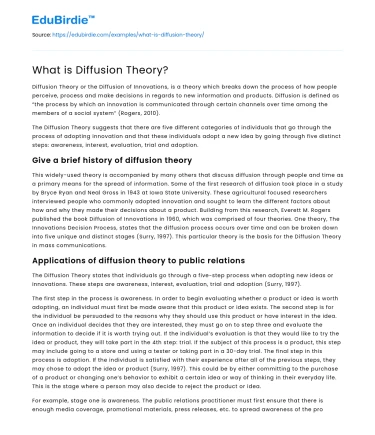Diffusion Theory or the Diffusion of Innovations, is a theory which breaks down the process of how people perceive, process and make decisions in regards to new information and products. Diffusion is defined as “the process by which an innovation is communicated through certain channels over time among the members of a social system” (Rogers, 2010).
The Diffusion Theory suggests that there are five different categories of individuals that go through the process of adopting innovation and that these individuals adopt a new idea by going through five distinct steps: awareness, interest, evaluation, trial and adoption.
Save your time!
We can take care of your essay
- Proper editing and formatting
- Free revision, title page, and bibliography
- Flexible prices and money-back guarantee
Give a brief history of diffusion theory
This widely-used theory is accompanied by many others that discuss diffusion through people and time as a primary means for the spread of information. Some of the first research of diffusion took place in a study by Bryce Ryan and Neal Gross in 1943 at Iowa State University. These agricultural focused researchers interviewed people who commonly adopted innovation and sought to learn the different factors about how and why they made their decisions about a product. Building from this research, Everett M. Rogers published the book Diffusion of Innovations in 1960, which was comprised of four theories. One theory, The Innovations Decision Process, states that the diffusion process occurs over time and can be broken down into five unique and distinct stages (Surry, 1997). This particular theory is the basis for the Diffusion Theory in mass communications.
Applications of diffusion theory to public relations
The Diffusion Theory states that individuals go through a five-step process when adopting new ideas or innovations. These steps are awareness, interest, evaluation, trial and adoption (Surry, 1997).
The first step in the process is awareness. In order to begin evaluating whether a product or idea is worth adopting, an individual must first be made aware that this product or idea exists. The second step is for the individual be persuaded to the reasons why they should use this product or have interest in the idea. Once an individual decides that they are interested, they must go on to step three and evaluate the information to decide if it is worth trying out. If the individual’s evaluation is that they would like to try the idea or product, they will take part in the 4th step: trial. If the subject of this process is a product, this step may include going to a store and using a tester or taking part in a 30-day trial. The final step in this process is adoption. If the individual is satisfied with their experience after all of the previous steps, they may chose to adopt the idea or product (Surry, 1997). This could be by either committing to the purchase of a product or changing one’s behavior to exhibit a certain idea or way of thinking in their everyday life. This is the stage where a person may also decide to reject the product or idea.
For example, stage one is awareness. The public relations practitioner must first ensure that there is enough media coverage, promotional materials, press releases, etc. to spread awareness of the product or idea at the center of the campaign.
The second step of interest or persuasion tells the practitioner that they will need to somehow convince the consumer of why they will need this product or why they should care about an idea. This can be done through fact sheets, comparison to similar things, relevant statistics or simply telling the consumer why it will make their life better.
The third and fourth steps of evaluation and trial tell the public relations practitioner that the consumer will need to be able to somehow try this idea or product without a formal commitment. In order to allow for this, they might implement something such as a 30-day trial, or a tester product in a store. Ideas are more difficult to measure in steps because a person is able to change their way of thinking freely, but these steps tell the practitioner that a trial period will take place while the consumer decides whether or not to care about the idea.
The final step, adoption, is the end goal for a public relations practitioner. This is where an individual will make the decision to either buy or reject a product, or jump on board and change their way of thinking and behavior as a result of the campaign. If many people did not adopt the main goal of a campaign, a practitioner can evaluate the previous steps and see how they can be changed and improved upon in the future.
References
- Kaminski, J. (2011). Diffusion of innovation theory. Canadian Journal of Nursing Informatics, 6(2), 1-6.
- Rogers, E. M. (2010). Diffusion of innovations. Simon and Schuster.
- Surry, D. W. (1997, February). Diffusion theory and instructional technology. In Proceedings of the Annual Conference of the Association for Educational Communications and Technology (pp. 1-12).






 Stuck on your essay?
Stuck on your essay?

